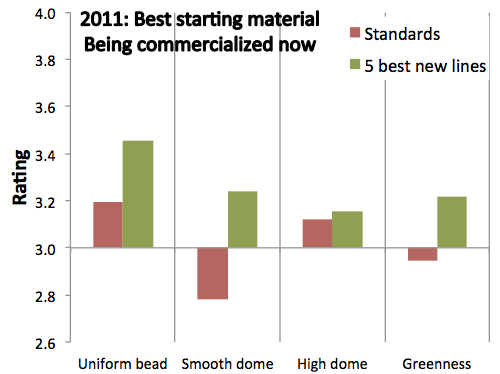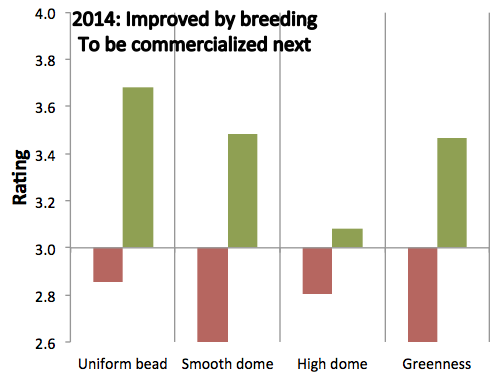Project Director
Thomas Björkman
Phone: 315-787-2218
Email: tnb1@cornell.edu
Department of Horticulture
Cornell University
Breeding Eastern Broccoli
The climate and variable weather in the eastern United States pose challenges for broccoli growers. This cool season crop suffers structural abnormalities under the hot and humid conditions that can characterize eastern summers (see the Flower Development page for an explanation), and the variable weather can make yield, quality, and time to maturity more difficult to predict.
Most broccoli consumed in the US is harvested from hybrid cultivars specifically developed for California production environments. The creation of new hybrid broccoli varieties targeted to eastern growing conditions is a critical goal of this project. We have assembled substantial resources to accomplish this objective, including all three public broccoli breeding programs and three private seed companies with large US broccoli programs. Thus, we have access to germplasm and expertise that will produce the new varieties.
Recent work by team member Mark Farnham at the USDA Vegetable Research Laboratory in Charleston, SC, has led to the development of broccoli lines that are adapted to the warm summer conditions of the southeastern United States. Farnham has also developed lines with disease resistance and enhanced nutritional content.
Philip Griffiths, of the Vegetable Breeding Program at Cornell University's Experiment Station in Geneva, NY, works with broccoli lines from Cornell's collection and also has access to the international Brassica collection of Horticultural Research International in Wellesbourne, UK. His selections are being used to develop hybrid combinations for adaptation to the hottest conditions that occur in the Northeast, and wiht improved disease resistance.
James Myers of Oregon State Universit, while based on the West Coast, has developed broccoli lines with a number of useful features, incuding elongated heads for ease of harvest, tolerance to heat and other stresses (particularly in those found in organic systems), dark green color, and high phytonutrient content.
Our three commercial seed company collaborators – Bejo, Syngenta, and Monsanto – have used their own broccoli germplasm and considerable know-how to specifically develop new hybrids for the eastern US.
Our breeding progress has been excellent.
When we began in 2011, the best hybrids from previous breeding efforts were slightly better than standard varieties on the market. In just a few years of intense breeding, the best hybrids in the 2014 trials are nearly full commercial quality in our testing environments.

Four of the most important traits were scored across 10 environments in our Phase I trials. A score of 3.0 is the minimuym commercial quality. A score of 4.0 is full commercial quality. The five new hybrids that scored best for subjective overall quality are compared with the six standards.

The some of the top hybrids form the 2011 trial have been commercialized. The top hybrids from 2014 will be commercialized if the project receives funding for the second five-year term.